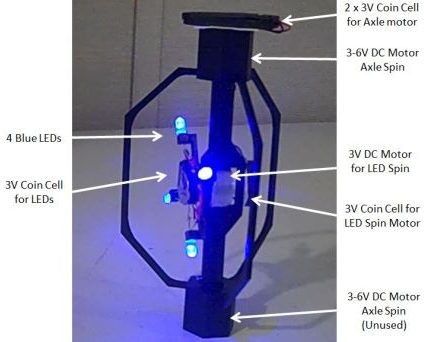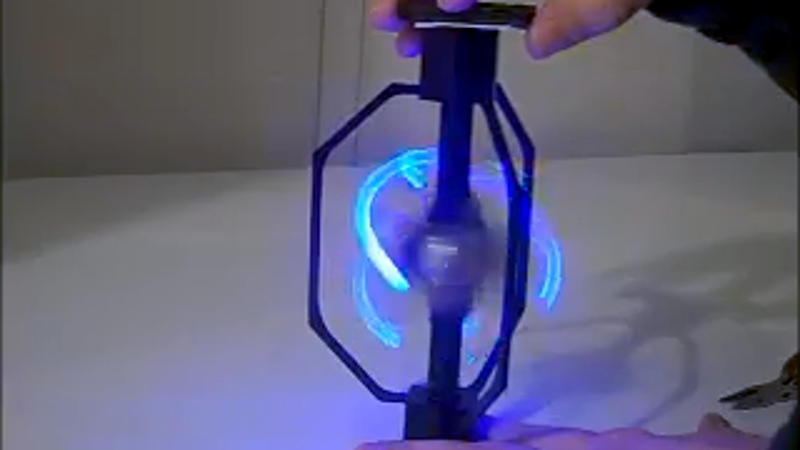 [Bithead] wanted to make a prop replica of an Electrostaff from Star Wars, but wasn’t sure how best to create the “crackling arcs of energy” effect at the business ends. After a few false starts, he decided to leverage the persistence of vision effect by spinning LEDs in more than one axis to create helical arcs of light and it seems that this method has some potential.
[Bithead] wanted to make a prop replica of an Electrostaff from Star Wars, but wasn’t sure how best to create the “crackling arcs of energy” effect at the business ends. After a few false starts, he decided to leverage the persistence of vision effect by spinning LEDs in more than one axis to create helical arcs of light and it seems that this method has some potential.
Many multi-axis persistence of vision devices use a component called a slip ring in order to maintain electrical connections across rotating parts, but [Bithead] had a simpler plan: 3D print a frame and give each axis its own battery. No centralized power source means a quicker prototype without any specialized parts, and therefore a faster proof of concept to test the idea.
[Bithead] already has improvements planned for a new version, but you can see the current prototype in action in the short video embedded after the break.
Slip rings can add bulk, but that’s offset by the advantage of putting power and electronics somewhere other than on the spinning parts themselves. An example of this is this Lucky Cat POV display, which uses a slip ring to let the arm spin freely while a microcontroller drives the LEDs on the paw.















I have not done the arithmetic, but it sure looks like the torque due to gyroscopic precession must be huge, trying to whip that rotating wheel around at that rate. I can’t imaging the batteries (or the bearings) are going to last very long. I’m guessing [Bithead] didn’t bother to do the arithmetic either.
You can also put a counterweight on one to do just that. Making an adjustable weight / cutting some off until it balances is fairly easy and doesn’t require (much) math.
Uhh, no. Balance has nothing to do with it.
He’s applying a torque with the top motor, trying to change the axis of rotation of a rapidly-spinning wheel of LEDs. It’s going to take a lot of torque.
This might help: https://youtu.be/N92FYHHT1qM?t=842
If you split the leds and had two counter rotating ‘horizontal’ spinners, You could cancel out most of the torque effects the vertical axis would have to take. Though you might not have the space for a second motor or gearbox to split a single motor output. Actually, If you made a little gearbox with a fixed central gear attached to the external housing, you could set up your two counter rotating spinners with only a single motor for the whole affair, by spinning the central shaft from one end, and having the two horizontal spinners drive gears pushing against the other fixed end.
I can’t imagine a couple of cheap af industrial grade 608 bearings breaking because of that anytime soon IMHO
If he’s already doing POV it might be better to just spin a column of LEDs or two and work out how to animate lightning bolts on it.
But then he ha s to add a lot more LEDs. I think if he went the slip ring route to remove the mass of the battery and reduced the mass again with a smaller motor he could probably get away with using only one LED and animate that.
Should look into wireless charging to power the LED. The LED won’t need a lot of power, so the range could be extended.
Can be done even simpler: There is an unused axial spin motor on the other end (now just used as a bearing). swap that motor around and use it as a generator, and power the LED motor and LED’s with that.
Why not just add a spinning Jacob’s Ladder device and make the real thing?
Is it possible to buy this ? Id love to make an electrostaff so Id be ready to buy two of these (built with color and sound effects)